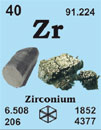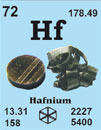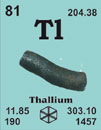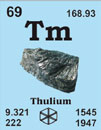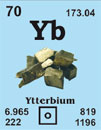Tellurium 52Te127.60
Tellurium was discovered in1783 by Baron Franz Joseph Müller von Reichenstein at Sibiu, Romania.
[Latin, tellus = earth]
French: tellure
German: tellur
Italian: tellurio
Spanish: teluro
Description: Tellurium is a silvery-white, metallic-looking in bulk, but is usually obtained as a dark grey powder. It is a semi-metal. Tellurium burns in air or oxygen, is unaffected by water or HCl, but dissolves in HNO3. It is used in alloys to improve machinability, in electronics, and in catalysts.
Tellurium single crystal properties
| State: |
Single crystal |
|---|
| Crystal structure: |
Hexagonal |
|---|
| Production method: |
Czochralski |
|---|
| Standard size: |
diameter 10mm
thickness 1-2mm |
|---|
| Orientation: |
(0001), (1100) and (11-20) |
|---|
| Orientation accuracy: |
<2°, <1°, <0.4° or <0.25° |
|---|
| Polishing: |
as cut, one or two sides polished |
|---|
| Roughness of surface: |
<0.03µm |
|---|
| Purity: |
99.999% |
|---|
| Typical analysis (ppm): |
C 3
H < 1
O 9
N < 5
Cu 1.60
Fe 1.80
Ni < 1
Pb 0.30
Si 0.30
Ga, Hf and Ta are below the detection limit
|
|---|
Materials properties
| Density: |
6.24 g/cm3 |
|---|
| Melting point: |
449.55 °C / 722.7 °K |
|---|
| Boiling point: |
989.85 °C / 1263.0 °K |
|---|
| Molar volume: |
20.45 cm3 |
|---|
| Thermal conductivity: |
2.35 [300 K] Wm-1K-1 |
|---|
| Coefficient of linear thermal expansion: |
16.75 x 10-6 K-1 |
|---|
| Electrical resistivity: |
4.36x 10-3 [298 K] Wm |
|---|
| Mass magnetic susceptibility: |
-3.9 x 10-9(s) kg-1m3 |
|---|
| Young's modulus: |
47.1 GPa |
|---|
| Rigidity modulus: |
16.7 GPa |
|---|
| Bulk modulus: |
n.a. GPa |
|---|
| Poisson's ratio: |
0.16 - 0.3 |
|---|
| Radii: |
Te3+ 56; Te4+ 97; Te2- 211; atomic 143; covalent 1 |
|---|
| Electronegativity: |
2.1 (Pauling); 2.01 (Allred); 5.49 eV (absolute) |
|---|
| Effective nuclear charge: |
6.95 (Slater); 10.81 (Clementi); 13.51 (Froese-Fischer) |
|---|
| Number of Isotopes (incl. nuclear isomers): |
39 |
|---|
| Issotope mass range: |
108 -> 137 |
|---|
| Crystal structure, (cell dimentions / pm), space group |
Hexagonal |
|---|
| X-ray diffraction: mass absorption coefficients: |
CuKα 282 (µ/r) / cm2g-1
MoKα 35.0 (µ/r) / cm2g-1 |
|---|
| Neutron scattering length: |
0.580 b/10-12 cm |
|---|
| Thermal neutron capture cross-section: |
4.7 sa / barns |
|---|
Biological data
| Biological role: |
none |
|---|
| Toxicity |
|
|---|
| Toxic intake: |
Elemental tellurium has low toxicity but unpleasant side effects, producing extremely unpleasant bre |
|---|
| Lethal intake: |
2 g of sodium tellurite has proved fatal to a human. LD50 (Te metal, oral, rat)= 83 mg kg-1 |
|---|
| Hazards: |
Tellurium compounds are toxic by ingestion and intravenous routes. They are also considered to be experimental tetratogens. |
|---|
| Level in humans |
|
|---|
| Blood: |
0.0055 mg dm-3 |
|---|
| Bone: |
n.a. |
|---|
| Liver: |
0.014 p.p.m. |
|---|
| Muscle: |
0.017 p.p.m. |
|---|
| Daily dietary intake: |
c. 0.6 mg |
|---|
| Total mass of element in average [70 kg] person: |
c. 0.7 mg |
|---|
Geological data
| Mineral | Formula | Density | Hardness | Crystal apperance |
|---|
| Sylvanite |
AgAuTe4 |
8.16 |
1.5 - 2 |
mon., met. grey |
|---|
| Tellurite |
TeO2 |
5.90 |
2 |
orth., sub-adamantine white |
|---|
| Chief ore: |
none mined as such. Tellurium is obtained from the anode slime of copper refining. |
|---|
| World production: |
215 tonnes/year |
|---|
| Main mining areas: |
Sylvanite in Australia, USA and Romania |
|---|
| Reserves: |
n.a. |
|---|
| Specimen: |
available as granules, ingots, pieces or powder. DANGER ! |
|---|
| Abundances |
|
|---|
| Sun: |
n.a. |
|---|
| Earth's crust: |
c. 0.005 p.p.m. |
|---|
| Seawater: |
|
|---|
| Residence time: |
|
|---|
| Classification: |
scavenged |
|---|
| Oxidation state: |
IV and VI; mainly VI |
|---|
Source: Emsley, J. (1998) The Elements (3rd Edition)

 English
English
 Deutsch
Deutsch








































